 |
The Buckeye House Rabbit Society |
 |
go to other issues | homepage
 |
The Buckeye House Rabbit Society |
 |
Features
|
ShortsPersonal |
Chapter Messages |
|
go to index
by Dr. Gary Riggs DVM
Barberton Veterinary Clinic
Bird and Exotic Specialty Hospital
4873 Richland Ave.
Norton, OH 44203
1-800-530-1637
Pet rabbits today benefit from a surge of popularity and a focus on maximizing health, habitat and nutrition. As a result, they now enjoy longer lives than ever before. Although the benefits of this are obvious, the realities are that we now more than ever must recognize and minimize geriatric-associated health problems. Although generalities for geriatric care pertain to all animals, some problems can be more specifically associated with rabbits.
As your rabbit ages, much more attention must be paid to habitat and nutrition. In general, activity will decrease with age to some degree. If the same diet continues to be fed as activity and metabolism decline, obesity can result. As in any pet, obesity can lead to a multitude of problems. These include liver disease, heart disease, arthritis, and respiratory difficulties. In addition, sedentary/overweight rabbits become more prone to hock sores and other pressure-related lesions. While working on a reduced calorie plan, make sure moderate exercise is encouraged and resting areas are well padded.
The type of diet fed also requires more attention with age. Increasing fiber while decreasing the general richness of the diet aids dental health, gastrointestinal health, cardiovascular health and weight control. Simply making grass hays and greens a higher percentage of the diet and minimizing pellets, treats, and rich hay will usually achieve the desired results. In certain cases your veterinarian may also recommend selected vitamin and mineral supplements to help out in specific senior nutritional problems.
Older rabbits who seem to have trouble eating, refuse food or salivate inappropriately need to be examined for dental abnormalities. It is not uncommon for rabbits who have never experienced dental problems in the past to develop them in later years due to dental wear, damage, and changing eating habits. Dental trimming is a routine part of geriatric health.
Even with proper care and diet, health problems will often surface. As with any person or pet, arthritis is often the reward for living well. Recognizing the signs of early arthritis in your pet is just as important as treating the ailment. Reluctance to move, hock sores, muscle loss, excessive teeth grinding, or resistance to being handled are a few of the early warning signs. In later stages, pain vocalization and muscle loss are more vivid reminders of arthritic discomfort.
The type of treatment utilized for arthritis depends on the severity. If your pet is overweight, a gradual weight reduction is indicated. If the symptoms are minor, the arthritic symptoms can be helped and progression slowed by the use of oral chondroitin/glucosamine products. There are a couple of things to keep in mind about their usage though. First, not all products are created equal. Talk to your veterinarian to make sure the product you use has the best chance of doing the job. Secondly, results often take 4-6 weeks to reach maximum effect so don’t give up too soon. Once an effective level is reached, you are often able to back the dosage down to maintenance levels.
For more advanced cases of arthritis, an anti-inflammatory medication will need to be added to the glucosamine treatment. Although not approved for use in rabbits, many dog and human anti-inflammatories can be very effective and with the help of compounding pharmacists, they can be made into easy-to-administer, even tasty formulations. The goal of therapy is to reduce discomfort and to allow for increased exercise to help restore muscle tone for joint support. Long-term use will be needed although dosage may change.
Heart disease is also commonly seen in elderly rabbits and is also best treated early in its course. Signs include exercise difficulties, decreased appetite with weight loss, coughing, or other respiratory difficulties. Diagnosis can usually be made with a stethoscope and clinical signs although an electrocardiogram and chest x-ray can greatly aid in determining the severity of disease and best course of treatment. Diuretics, blood pressure medication, and heart strengthening medication can all be successfully used for treatment.
Kidney (or renal) disease is also seen in many older bunnies. The initial signs may be subtle or nonexistent. Due to the large reserve capabilities of the kidneys, a large portion of kidney activity must be compromised (over 60%) before signs are evident. Early signs of a problem include increased water intake, increased dilute urinations, and weight loss. Water intake should be encouraged and should never be withheld in older rabbits. Specific blood tests, radiographs (x-rays), ultrasound, and urinalyses can be used to diagnose and judge the severity of the kidney problems and help map out an effective course of treatment.
Another less common, less detrimental finding in these older pets is cataract formation. A rabbit with cataracts may be reluctant to move around, especially in new surroundings, and be sensitive to bright lighting. Close examination usually reveals the whitening of the pupil and sometimes a general inflammation of the eye. These are generally not painful and require no treatment unless secondary problems such as glaucoma arise. Cataracts are not always restricted to the elderly and can sometimes show up even at an early age in certain breeding lines where they are inheritable.
Of course, a more severe geriatric consequence can be neoplasia (cancer) development. Like most species, rabbits can play host to a multitude of cancer types involving most organ systems and clinical symptoms depend on what area is involved. It is important to detect these lesions as early as possible in order to maximize your chance for successful treatment. Although the risk for surgery is slightly increased with age, you shouldn’t be afraid of aggressive treatment for tumors that have a good prognosis. Radiographs, blood work, ultrasound and biopsies can all be important to determine the extent of the disease and the best course of treatment. In selected cases, chemotherapy can even be a good treatment choice with minimal side effects and the ability to extend the quantity and quality of your pet’s life.
Rabbits can certainly live a long and happy life. Careful attention to habitat, diet, and exercise can pay big dividends in the form of quality longevity. Routine examinations with early screening blood work and x-rays along with home monitoring of weight, routine, and activity are cornerstones to a comprehensive senior health plan. Early detection and treatment is the key. Your bunny will thank you for it.
go to index
by Kristen Doherty
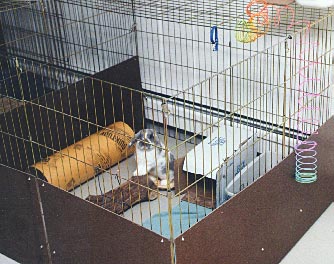 |
|
On the lookout! |
In the fours years of running a foster home, my husband and I have tried several different housing arrangements for both foster rabbits and our own. We’ve finally come to the conclusion that, by far, portable wire exercise pens are the most versatile, the easiest to clean, and the best way to bring out the most desirable qualities in a rabbit. For those who want a quick housing solution without spending a lot of time and money, the wire pen arrangement gives you the most bang for your buck and your time.
In my experience of housing more than 80 rabbits over the years, I have seen a marked difference in a rabbit’s attitude and behavior when he goes from being caged several hours a day to having an entire penned-in area as his own home base. After all, wouldn’t you want a bigger house rather than a small house, if you didn’t have to clean it yourself? I’ve noticed that the larger the space that the rabbit can claim as her own, the less territorial she becomes. Occasionally I get calls from shelters and other rabbit owners who tell me a rabbit nipped them when they stuck their hands into the cage, or when trying to refill food/water bowls, clean litterboxes, and so forth. In most cases, once a rabbit graduates to an exercise pen, this territorial aggression disappears. For some rabbits, there may still be some grunting when food bowls are rearranged, but the degree of territoriality is not nearly what it was when the rabbit was caged.
Exercise pens also allow for the bunny to see what is going on around her. This gives her a feeling of knowing what’s happening and of being included in the household activities. The bunnies in my foster home immediately get up from their naps or relaxed positions to watch me do laundry or other chores. They love to watch the activity.
My husband and I started off on the pen idea by first building rectangular pens out of recycled plywood. Wall heights were adjusted according to the ability of each rabbit to jump over a wall. The pens averaged roughly 4’ x 4’, or 16 square feet. The plywood walls, however, had several disadvantages. They were somewhat inflexible in size and shape, they required some light carpentry skills, and they soak up urine rapidly, rotting the wood over time. Also, they don’t allow the bunny to see much of what’s going on outside of the pen.
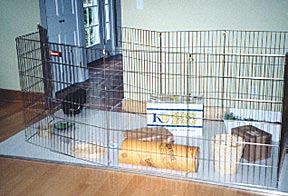
Emma's home base |
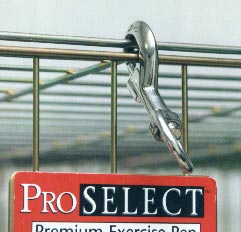
Dog leash clips |
|
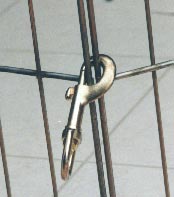 |
||
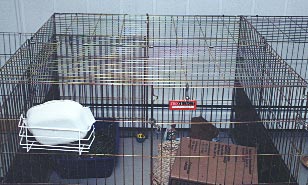 |
Pen with a lid | |
After two years of the plywood pens, we decided to upgrade to wire exercise pens. Exercise pens are made up of eight heavy-gauge wire "panels", all connected together, so that they can be stretched out and shaped into a square, rectangle, octagon, or whatever shape you want. Each panel is 24" wide. The total space when panels are made into a square is 4’ x 4’, or 16 square feet (for a bonded pair, I’d recommend two pens and a space not less than 4’ x 6’). When purchasing the pens, you can choose from these heights: 24", 30", 36", 42", or 48". I’d recommend a 30" height, 36" for jumpers. One of the eight panels acts as a swinging door when opened, and the pen is secured shut with large dog leash clips that come with the panels. Note: the wire slats of the pen must be close enough together so that a tiny rabbit cannot walk through! When not in use, the panels fold up like an accordion and can be easily stored in a closet. They can also be easily transported by car to another location.
For a larger space, many people choose a corner of a room, using the two corner walls as walls of the pen. This makes an even bigger space for the rabbit, since you have all eight panels to complete just two sides of the pen. They can be secured to the wall using the large clips and eye hooks, which can be purchased at any hardware store.
Exercise pens are a good solution for blocking off areas in your home where you don’t want bunny to go.
To make the pen area smaller, overlap two or three panels and clip together. There is no need to take the panels apart. Need a bigger pen? Buy two and overlap panels as necessary. Is your bunny a jumper? Do you want to keep the cats out? Make a "lid" for the top by placing two 48-inch high panels horizontally over the top of the pen (individual extension kits can be purchased, two panels per kit, without having to purchase an entire pen). Secure the lid to side panels with large leash clips, so that one panel opens on a hinge, while the other stays in place.
To clean the pens, we fold up as many panels as we need to, let bunny out to run around, and vacuum/wipe the floor. Occasionally we need to wash or disinfect the panels themselves. To do this, we either take them outside and hose them down with a brush attachment, or in inclement weather, we wash the bottom half of the pens, folded up, in our laundry tub.
Flooring
You may use any type of flooring you wish, as long as it’s safe for the bunny. Our floors are painted concrete with throw rugs. We also use pieces of pre-cut linoleum, which can be purchased at home centers for a reasonable price. If you want to add a finished look to the piece of linoleum, glue it to a large piece of plywood and finish the edges with framing or edging material, the kind you would find on an office whiteboard. We make the linoleum-covered platform large enough so that the pen sits nicely on top of it. This of course will require some extra time, money, and effort, but is well worth it.
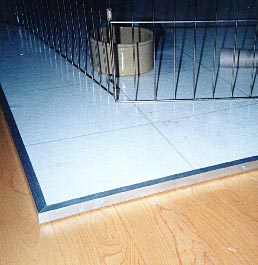 |
|
|
Linoleum platform edging |
Inside the pen, make sure the bunny has a place to hide when she wants to be left alone, sleep, or take refuge from the vacuum cleaner. We place a cardboard "hide" box or tube in each pen for this purpose. Safe ramps, pedestals, and multilevel boxes can also be added. If you want to make use of bunny’s former cage, place it inside the pen area. This is bunny’s personal space, where only she is allowed.
Place a litterbox in one corner of the pen. I have seen dramatic improvements in litterbox habits when bunny goes from cage to pen. Many people tell me that their caged bunny -- even when spayed or neutered -- will not use the litterbox inside the cage. Once the bunny has more freedom to move about and "get organized", he usually wants to keep his toilet area neater.
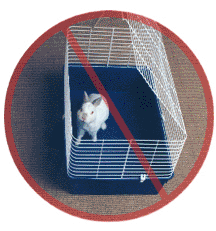 |
|
Inappropriate housing for |
If you really don’t think you have the space for a pen, I highly recommend wire dog crates, no smaller than 3’W x 2’L x 27"H. They come with a hard plastic, easily washable floor, and many are collapsible. This is large enough for a litterbox, some dishes, and space for the bunny to move around. You will not find these in the rabbit section of a pet store. Look in the dog and cat aisles instead.
The popular 16"W x 25"L x 15"H cages sold as rabbit housing (see photo) are inappropriate long-term accommodation for any size rabbit. With litterbox, dishes, water, and toys, there isn’t enough room for bunny to even turn around. The top of these cages hinges open, making it dangerous for bunny to hop in and out. I use these units as car carriers. The top comes off, so I also use the plastic bottom as a giant litterbox for larger rabbits or pairs.
I call exercise pens the "guilt-free" way to house a bunny. While you are at work or asleep, bunny has the freedom to move around as he pleases. It’s a happy medium between caged housing and free roam. For those of you with free-roaming rabbits, good for you! Many rabbits have been granted free-run privileges, or enjoy free run in combination with minimal time in a pen.
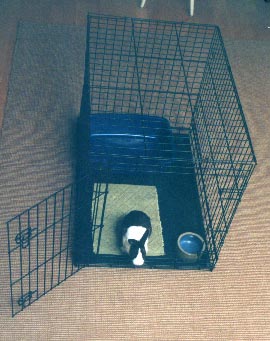 |
|
Large dog crate, the minimum living space |
When shopping for exercise pens, you will not find them in the rabbit aisle of a pet supply store. I purchase our exercise pens through mail order. I find the least expensive pens (including shipping costs) at New England Serum Company, a pet supply company (1-800-NE-SERUM, or www.neserum.com). These pens typically go on sale once or twice a year for ten dollars less than the normal price. New England Serum, as well as other pet supply catalogs, also carries a large selection of dog crates.
go to index
go to index
|
New members who join for $28.00 both National and Buckeye HRS will receive the Original Print seen here, created by Ohio artist Eileen Matias especially for the Buckeye House Rabbit Society (while supplies last -- this is a limited run of only 50 prints).
Of Course I'm Cute
|
||
|
|
||
Artist's Statement
|
||
| If you are wanting to join, please click here for the membership form. Do not use the gift order form for this item. | If you are already a member, you too can enjoy this print with a special donation of $20.00 or more -- while supplies last. Please see special ordering instructions below. | |
For members making a special donation, you can: Buckeye HRS, Please do not use gift order form for this special item. |
||
|
||
go to index
Congratulations and best wishes to these cherished bunnies and their devoted human companions!
Celebrating in September:
Starlight with Cheryl; Carmel, 5 years with Christine; Chip with Kathy; TipToe, 2 years with Wendy; Lulu, 3 years with Julia and Annie; Corky, 3 years with Eileen and Joseph; Lucy, 5 years with Kris; Rosie, 4 years with Linda and Rob.
Celebrating in October:
Zoe, 2 years with Michella; Bigwig, 2 years with Jennifer and Eric; Boo, 2 years with Joyce; Chili, 4 years with Adrian; Figaro, 3 years with Susan; Murphy, 3 years with Michele; Raisin with Lisa; Gus with Amy; Omar with Clay and Nancy; Annabelle with Linda; Snoopy, 4 years with Debi; Stormy and Mr. McGregor with Kathy; Pogo and Treasure, 1 and 2 years, respectively, with Wendy; Tootie, Max, and Popper, 1, 3, and 2 years, respectively, with Liz; Cinders, 7 years with Jim and Kaye; Zeider Zee, 3 years with Patrick and Carla; Maggie, 3 years with Stacie; Sasha, 6 years with Kate; Snowball, 4 years with Cathy; Jillie with Suzanne and Dan.
Celebrating in November:
Snickers, 9 years with Diane; Flopsy, 3 years with Barbara; Buddy with Allie; Ping and Pong, 1 year with Cara; Smudge, 7 years with Bob; Tribble and Pooky, 5 years with Joyce; Laurel with Scott; Clover, 3 years with John and Mary Jo; Lucy with Terri and Jeremy; Chloe, 1 year with Pam and Ron; Pepper and Ginger with Clay and Nancy; Reuben, 2 years with Henry and Susan; Ryan, Fred, Snowball and J.J. with Ann; Jessica, 3 years with Keith; Rosie, 2 years with Marcia; Cooper Bun-Bun, 5 years with Gina; Marble, 2 years with Kurt and Holly.
Celebrating in December:
Oscar, 8 years with Pat; Nikki with Bill and Jolene; Bundles, 3 years with Henry and Susan; Dakota with Scott; Lauren with Kathy; Sunshine, 3 years with Jim and Kaye; Rudy, 5 years with Kathryn; Irving and Vincent, 2 and 3 years, respectively, with Carla and Patrick; Richmond, 3 years with David and Herta; Nicky, 3 years with Susan; Holly with Christine; Zoe, 4 years with Dennis and Shirley.
go to index
This webzine is based entirely on the Harelines printed newsletter. The printed copy is sent out to members much before it appears here -- that's one way we can encourage you to support it by becoming a member. If you find you are reading this website regularly or with special appreciation, please consider becoming a member of the Buckeye House Rabbit Society.
| Now's the time to join! Your $10 membership donation pays for one year's issues of Harelines AND helps us help needy rabbits here in Ohio. We are an all-volunteer, federally-recognized non-profit organization and depend solely on YOUR generous support. Don't forget, your donation is tax-deductible! | 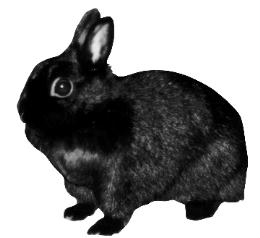 |
Don't let this issue of Harelines be the last to reach the web. Send your membership to us today!
go to index
Heidi Metzger, for hosting this year's northeast-area picnic.
Corinna Stephens, for donating her lovely rabbit painting for the northeast picnic raffle.
Debi Britton, for her most generous donation in memory of her beloved Honey bunny, who crossed the Bridge on June 8, and her former foster rabbit, Nosey, who also passed away recently.
Brian, Patty, Jarry and Ed Bailys, Tracy Brodsky and Sharon from Pet Paradise, for their kind donations in memory of Leo Bailys.
Barbara Bernard, for her tribute to Bucky.
Kim Johnson and Rob Lovicz, for their contribution in memory of Zoe.
Amy Pecsok, for her generous gift in honor of her cherished Moon, who passed away in April.
Michella Stultz-Karapondo, for her thoughtful donation in honor of Mary Kalb’s Leo the Lop.
The Monks Copy Shop of Worthington, for their discount on printing our newsletter.
Harelines, the Buckeye House Rabbit Society Newsletter, is published by the all-volunteer, non-profit Buckeye House Rabbit Society, Vickery, OH. The House Rabbit Society assumes no responsibility for errors or omissions.
Newsletter editor Herta Rodina
Layout and Design Ellen B. Eder
Contributing Writers
Kristen Doherty
Eileen Matias
Dr.
Gary Riggs
Webster
David Sharpe
go to beginning | contents | homepage
This page is maintained by David Sharpe (www.ohio.edu/people/sharpe)
Please send comments to
All rights reserved
![]()